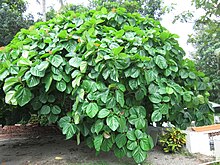Ficus auriculata
| Roxburgh fig | |
|---|---|

| |
| Scientific classification | |
| Kingdom: | Plantae |
| Clade: | Tracheophytes |
| Clade: | Angiosperms |
| Clade: | Eudicots |
| Clade: | Rosids |
| Order: | Rosales |
| Family: | Moraceae |
| Genus: | Ficus |
| Subgenus: | F. subg. Sycomorus |
| Species: | F. auriculata
|
| Binomial name | |
| Ficus auriculata | |
| Synonyms[2] | |
|
List
| |
Ficus auriculata (the Roxburgh fig, Elephant ear tree) is a type of fig tree, native to subtropical parts of Asia. It is noted for its big and round leaves and edible fruit.
Description[edit]
This plant is a small tree of 5–10 m (16–33 ft) high with numerous bristle-covered branches. The leaves are big and round, and are up to 44 cm (17 in) long and 45 cm (18 in) wide, with cordate or rounded base, acute apex, and 5–7 main veins from the leaf base. Its petioles are up to 15 cm (6 in) long, and it has stipules of about 2.5 cm (1 in) long. The plant has oblate syconium that are up to 4 cm (1.6 in) wide, covered with yellow pubescence, and emerge from the trunk or old branches of the tree.[3][4] Ficus auriculata is dioecious, with male and female flowers produced on separate individuals.[5] On ripening, the fruits turn from light yellow to purple. The fruit is a fleshy receptacle. The fruits form as large clusters on the trunk, on branches and also on the roots.[6]
Fruit extracts contain many phenolic compounds (Gaire et al. 2011).[7]
Taxonomy[edit]
It was first published by Portuguese Botanist João de Loureiro (1717–1791), in Fl. Cochinch. on page 666 in 1790.[2]
It is commonly known as the Roxburgh fig,[8] which is named after botanist William Roxburgh, who was appointed Superintendent of the Calcutta Botanical Gardens by the East India Company in 1793. Experiments carried out on fruiting Ficus auriculata trees at the Calcutta Botanic Gardens by the then Superintendent George King and his Botanic Garden colleagues described in King in 1897 which was the first detailed explanation of how the dioecious figs were pollinated by fig wasps which bred in the figs of male trees and then flew to female fig trees to pollinate the female figs.[9] It is also known as Elephant Ear Fig Tree, Elephant Ear Tree and Giant Indian Fig, due to the leaves, as auricle is the Latin word for ear, referring to the two 'ears' at the base of heart shaped leaf.[6]
Distribution[edit]
The native range of this species stretches from north-eastern Pakistan to southern China and the Malaysian peninsula. It is found in the countries (and regions) of Assam, Bangladesh, Cambodia, southern China, East and West Himalaya, Hainan, India, Laos, Malaya, Myanmar, Nepal, Pakistan, Thailand, Tibet and Vietnam.[2]
Habitat[edit]
It grows in forests in moist valleys,[3] growing along stream banks.[6]
Ecology[edit]
Ceratosolen emarginatus is an insect that helps to pollinate this plant.[10][11]
Uses[edit]
The fresh fruit of this plant is consumed as food, and has diuretic, laxative and digestive regulating properties.[4] Ficus auriculata is used as fodder in Nepal. It is least resistant to fire, but likes good sunlight.[12]
The large leaves, often up to 21 in (533.4 mm) long and 12 in (304.8 mm) wide are used as plates.[6]
Plant problems[edit]
The tree is susceptible to scale. It also has minor issues with gall, mealy bugs, thrips, whitefly, and spider mite.[6]
Photo gallery[edit]
-
Fruit emerging from trunk and branches
-
Leaf of elephant ear fig
-
Fruit
-
Leaf
-
Fruit
-
Seeds
References[edit]
- ^ Shao, Q.; Zhao, L.; Botanic Gardens Conservation International (BGCI).; IUCN SSC Global Tree Specialist Group (2019). "Ficus auriculata". IUCN Red List of Threatened Species. 2019: e.T147637124A147637126. doi:10.2305/IUCN.UK.2019-2.RLTS.T147637124A147637126.en. Retrieved 19 November 2021.
- ^ a b c "Ficus auriculata Lour. | Plants of the World Online | Kew Science". Plants of the World Online. Retrieved 25 October 2023.
- ^ a b "29. Ficus auriculata". Flora of China.
- ^ a b Tanaka, Yoshitaka; Van Ke, Nguyen (2007). Edible Wild Plants of Vietnam: The Bountiful Garden. Thailand: Orchid Press. p. 96. ISBN 978-9745240896.
- ^ Kuaraksa, Cherdsak; Elliott, Stephen; Hossaert-Mckey, Martine (2012). "The phenology of dioecious Ficus spp. Tree species and its importance for forest restoration projects". Forest Ecology and Management. 265: 82–93. doi:10.1016/j.foreco.2011.10.022.
- ^ a b c d e "Ficus auriculata (Elephant Ear Fig Tree, Elephant Ear Tree, Giant Indian Fig, Roxburgh fig) | North Carolina Extension Gardener Plant Toolbox". plants.ces.ncsu.edu. North Carolina State University. Retrieved 25 October 2023.
- ^ Gaire, B.P.; Lamichhane, R.; Sunar, C.B.; Shilpakar, A.; Neupane, S.; Panta, S. (2011). "Phytochemical screening and analysis of antibacterial and antioxidant activity of Ficus auriculata (Lour.) stem bark". Pharmacognosy Journal. 3 (21): 49–55.
- ^ USDA, NRCS (n.d.). "'Ficus auriculata'". The PLANTS Database (plants.usda.gov). Greensboro, North Carolina: National Plant Data Team. Retrieved 9 October 2022.
- ^ King, George (1888). The species of Ficus of the Indo-Malayan and Chinese countries. Calcutta: Bengal secretariat press. pp. 67–185.
- ^ LI Zong-Bo; YANG Pei; PENG Yan-Qiong; YANG Da-Rong (2012). "Distribution and ultramorphology of antennal sensilla in female Ceratosolen emarginatus Mayr (Hymenoptera: Agaonidae), a specific pollinator of Ficus auriculata". Acta Entomologica Sinica. 55 (11): 1272–1281.
- ^ van Noort, S.; Rasplus, J.-Y. (2018). "Ficus auriculata Loureiro, 1790". Figweb. Iziko Museums of South Africa.
- ^ "Ficus auriculata". ForestryNepal. Archived from the original on 2014-02-22. Retrieved 2014-02-24.
External links[edit]
 Data related to Ficus auriculata at Wikispecies
Data related to Ficus auriculata at Wikispecies Media related to Ficus auriculata at Wikimedia Commons
Media related to Ficus auriculata at Wikimedia Commons







